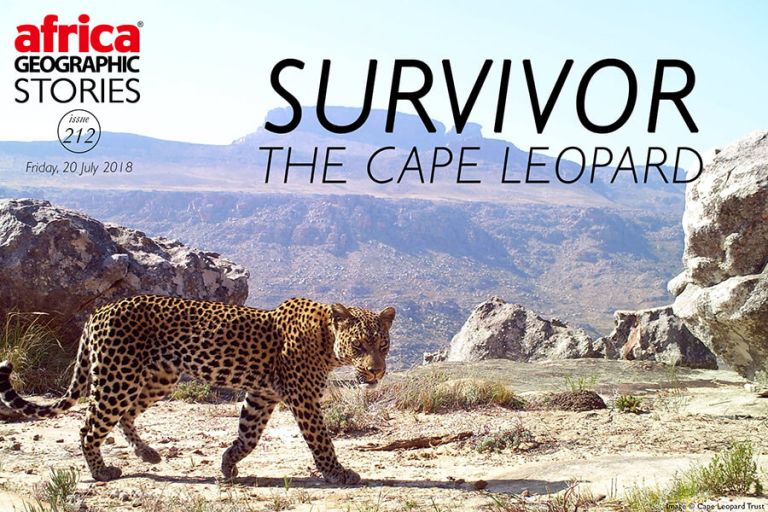THE STORY OF A LEOPARD POPULATION THAT BEATS THE ODDS
Simon Espley & The Cape Leopard Trust Friday
20 July 2018

The Cape leopard is the stuff of legends. This seldom seen, highly elusive apex predator survives in some of the most inhospitable habitat possible – the rugged, low nutritional fynbos biome of the Cape Fold Mountain ranges.
Despite the habitat limitations, this region did historically host many wildlife species such as black rhino, Cape mountain zebra, bontebok, Cape buffalo, hippopotamus, elephant, spotted hyena, brown hyena and wild dog – all of which now only occur in some fenced private and national game reserves in the Cape. The Cape lion, quagga and bluebuck also occurred in the area, but are now extinct.
The arrival of permanent European settlers signalled the death knell for these species in the wild, and 365 years later, the pressure has escalated. And yet the Cape leopard is hanging in there. And they do so with other hardy survivors such as African wildcat, chacma baboon, caracal (rooikat), Cape clawless otter, Cape fox, large-spotted genet, striped polecat, honey badger and several antelope species.
So, what is the Cape leopard’s secret? How does the Cape’s apex predator escape local extinction? In a nutshell, Cape leopards continue to survive because they are adaptive to change, opportunistic about food sources and because of the vastness of their home ranges.
 A fantastic view from the Maltese Cross parking area in the Cederberg © L. Müller
A fantastic view from the Maltese Cross parking area in the Cederberg © L. Müller
LET’S LOOK AT A FEW INTERESTING CAPE LEOPARD FACTS
- The Cape leopard (Panthera pardus pardus) is the same species as the savanna/bushveld leopard, despite the differences noted below. The southern African leopard population is comprised of a number of geographically isolated groups, with slight genetic differences caused by distance isolation. These differences are not enough to classify each group as a separate sub-species;
- Cape leopards are about half the mass of savanna leopards. On average males weigh in at around 35kg (savanna leopard 60-70kg), whereas females weigh around 20kg (savanna leopard 35-40kg);


Left: Front paw of a female leopard © J. Hayward;
Right: A leopard spoor (track/pug mark) left in the sand on Klipbokkop Mountain Reserve in the Boland. Leopard tracks in the Cape mountains measure between 6.5cm and 8.5cm from the front of the longest toe to the back of the main pad. The tracks of females are smaller than those of males, and a leopard’s front feet are bigger and rounder than its hind feet © J. Hayward
- Home ranges are far larger than those of savanna leopards. While male leopards in the Kruger National Park have a home range of 25 to 50km², the range of a male Cape leopard is between 200 and 1,000km²;
- Contrary to popular belief, Cape leopards do not commonly target livestock, unless food is scarce and there is an easy opportunity;
- Females give birth to two to three cubs in a litter, but conditions are very harsh in the Cape mountains and there is a high mortality rate in the first six months of a cub’s life;
- Leopards in Africa are classified as ‘Vulnerable’, but Cape leopards are more threatened than other leopards because of urbanisation and limited suitable habitat;
- Although one should obviously always be very cautious when encountering any predator, Cape leopards are generally extremely wary of people and will readily retreat – except when threatened or cornered. A Cape leopard sighting is normally only very brief – the leopard will appear as if from nowhere, stand still for a few seconds, and then disappear into the fynbos once more. There are no reports of unprovoked attacks on people in the Western Cape. However, if one were to corner a Cape leopard, or threaten a female’s cubs, they could be extremely dangerous;
- There is no definitive total for leopard numbers in the Western Cape, however data from recent studies in three distinct mountain areas suggest the number to be fewer than 1,000;
- Leopards are opportunistic and adaptive hunters. Cape leopards mainly target rock rabbits (dassies), klipspringers, Cape grysbok and porcupines. Baboons do not form a major part of their diet.
 Scott (BM12), a dominant male leopard in the Kogelberg Biosphere Reserve, stalking a porcupine. Porcupine forms a substantial part of leopard diet in the Boland © Rooi Els Conservancy
Scott (BM12), a dominant male leopard in the Kogelberg Biosphere Reserve, stalking a porcupine. Porcupine forms a substantial part of leopard diet in the Boland © Rooi Els Conservancy
MAIN THREATS
- Human-wildlife conflict:
- Illegal hunting with snares for bush meat – which depletes the prey base and also kills leopards which get caught in the snares despite not being the intended targets;
- Direct persecution by farmers in retaliation for livestock losses (guilty or not);
- Indiscriminate use of poisons and pesticides;
- Habitat loss and fragmentation;
- Roads and traffic;
- Too frequent and large-scale veld fires, which damage ecosystem health;
- Natural threats, particularly to cubs, include black eagles, snakes, disease, malnutrition and territorial killings by other leopards.



Clockwise from left: 1) A leopard caught around the abdomen by an illegal wire snare in the Boland © J. Sikich; 2) An example of an illegal wire snare set to catch grysbok, duiker and porcupine © J. Sikich; 3) Cape leopard road kill © P. Steens
HUMAN-WILDLIFE CONFLICT
Human-wildlife conflict is a complex issue and there is no simple single solution. Instead, there are various ways that can be used in combination – depending on the circumstances. The Cape Leopard Trust believes in a holistic livestock management strategy, instead of trying to manage predators.
In essence this means taking livestock off the predator’s menu. These methods include well-trained livestock guardian dogs, traditional herding, and keeping livestock in adequately fenced, predator-proof kraals at night.

A territorial adult male called Apollo in the Bainskloof mountains © Cape Leopard Trust
Farmers are often put in very difficult situations when it comes to livestock depredation by leopards. Education is key, and they need to understand how and why they need to protect their livestock rather than reverting to simply killing all predators using unselective and inhumane methods. Killing predators does not solve the problems in the long term, because new individuals will move in to take over the vacant territory. All predators fulfil a vital function in our ecosystem – without them, adverse knock-on effects are likely to be experienced.
In rare instances, one specific individual leopard may be classified as a ‘problem animal’ and dealt with as such by the authorities. The Cape Leopard Trust always tries to work with landowners and CapeNature to find viable long-term solutions that are effective and relevant to each particular farm.
WHY ARE CAPE LEOPARDS IMPORTANT?
These beautiful, enigmatic creatures epitomise wilderness, and that is reason enough for many people. For those that require more substantive reasoning, Cape leopards are the top (apex) predator in the Cape, which means that they are a vital cog in maintaining ecosystems and other species.

This is a big adult male known as CM42. He roams a large area in the Cederberg close to Krakadouw © Cape Leopard Trust
HOW CAN YOU HELP?
The Cape Leopard Trust is a non-profit, public benefit organisation, funded primarily by corporate funders, trust funds and private donors.
- Donate http://capeleopard.org.za/donate;
- Sponsor a camera trap: http://shop.capeleopard.org.za/product/sponsor-a-camera-trap;
- Sponsor a school camp or eco-club for disadvantaged children;
- South Africans only: Sign up for a MySchool MyVillage MyPlanet card and choose the Cape Leopard Trust as your beneficiary. The card is completely free and participating stores will donate a percentage of your spend to the charity of your choice http://www.myschool.co.za;
- Spread awareness of the Cape Leopard Trust and the need to protect leopard habitat and prey in order to ensure their long-term survival;
- Follow the Cape Leopard Trust on their website, Facebook, Instagram and Twitter for regular updates;
- While enjoying time out in nature, be on the lookout for illegal wire snares. Cut and disarm these snares and report them to the Cape Leopard Trust. Also report any other suspicious activity like other traps and feral dogs;
- Drive slowly and carefully through mountainous areas to avoid hitting wild animals – including leopards and their prey;
- Farmers: Adopt holistic livestock husbandry practices to avoid conflict with leopards;
- Property owners: Refrain from hunting/killing ‘agricultural or garden pests’ like porcupine, grysbok, duiker and dassie – these are leopards’ main prey.

The adult female is known as CF29 and the sub-adult is known as CU1. This photo was taken in the Cederberg near Dwarskloof © Cape Leopard Trust
THE CAPE LEOPARD TRUST
The Cape Leopard Trust was initiated in 2004 in the Cederberg to study the ecology of the Cape leopard. Dr Quinton Martins began his studies by hiking these mountains and searching for signs of leopards. Literature on the subject was almost non-existent, and yet they were being killed in large numbers. Quinton teamed up with farmer Johan van der Westhuizen as co-founder, supported by Dr Andrew Baxter – and so the Cape Leopard Trust was born. After a successful fundraising event, Leopard’s Leap Family Vineyards and Rand Merchant Bank Fund pledged their support, and momentum began building. Over the years, activities expanded to include projects in the Boland, Little Karoo, Namaqualand, and the Table Mountain National Park.



Clockwise from left: 1) The Boland researchers servicing a camera trap © S&A. Toon;
2) Tracking a collared leopard in the Kogelberg © A. Wilkinson; 3) A camera trap in the Jonkershoek mountains; © J. Hayward
The Trust also supports predator projects in partnership with the Dept. of Conservation Ecology at the University of Stellenbosch as well as the Animal Demography Unit (ADU) at the University of Cape Town. The Cape Leopard Trust Education and Outreach Programme (est. 2009) is a vital component of their work and operates mainly in the Cederberg Wilderness Area, the Boland Mountains and the Cape Peninsula.


Left: A leopard with a GPS collar fitted, ready to be released. Every leopard’s spot pattern is unique and can be used to individually identify different cats © J. Sikich;
Right: The Cape Leopard Trust research team taking measurements to fit a GPS tracking collar to a sedated leopard © P. van der Spuy
The Trust uses research as a tool for conservation, finding solutions to human-wildlife conflict and inspiring interest in the environment through an interactive and dynamic environmental education programme. Since its inception, it has become an authority on predator conservation in the Cape, and one of the leading authorities in SA.
The long-term vision is to ensure the long-term survival of leopard populations by promoting peaceful coexistence and the protection of landscapes, empowered by scientific research, positive community partnerships, education and advocacy.
Source: http://magazine.africageographic.com/weekly/issue-212/cape-leopard/
















